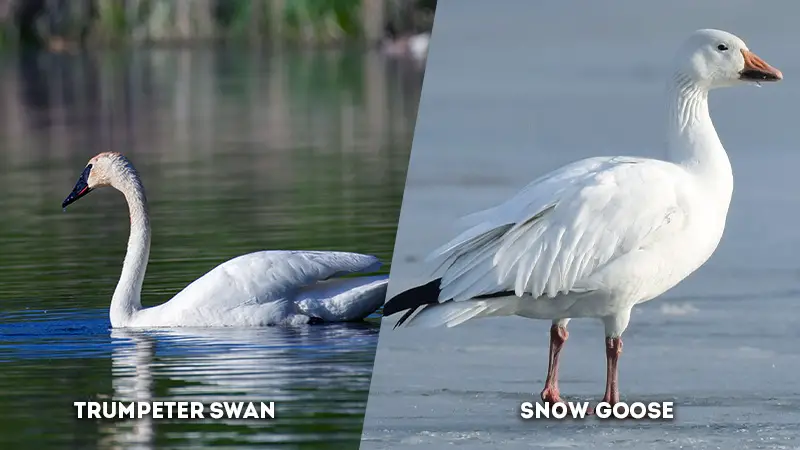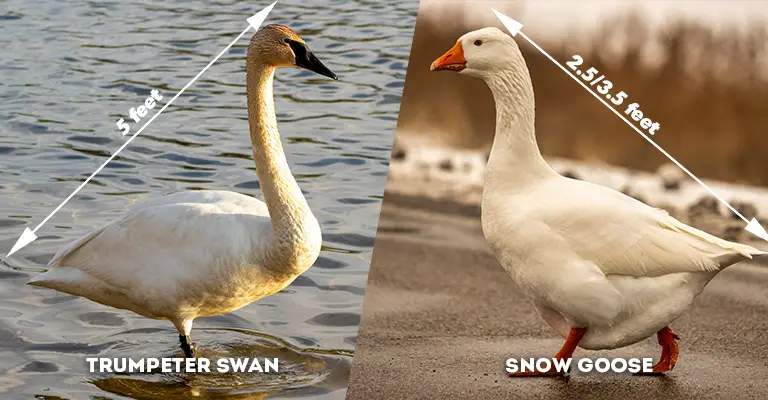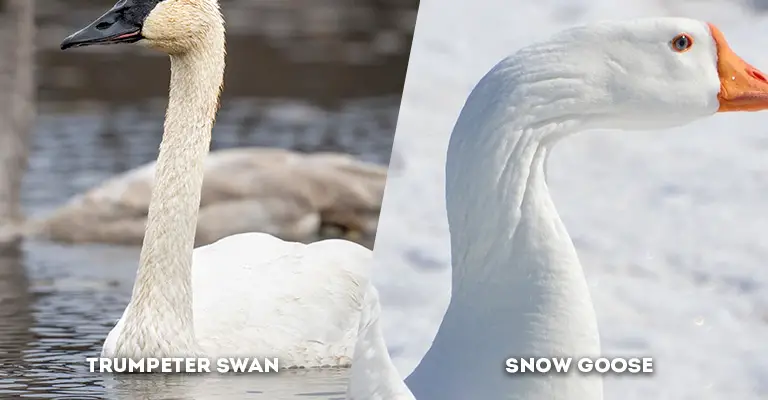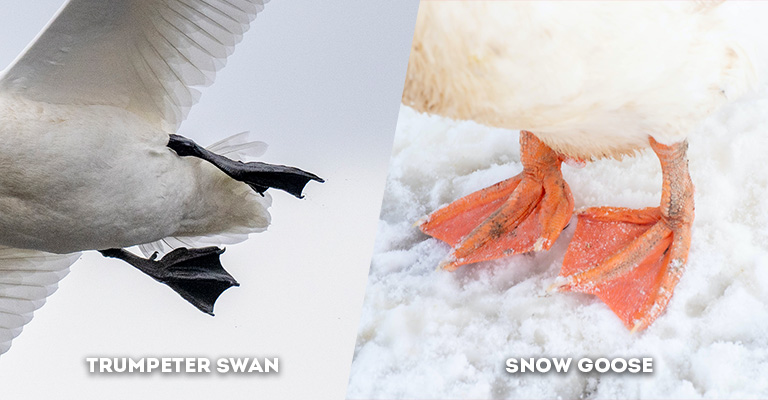Trumpeter Swans and Snow Geese are two captivating avian species that grace diverse habitats across North America. Their distinctive features, behaviors, and ecological roles set them apart in the avian world.
While the elegant Trumpeter Swan exhibits regal stature with its long neck and graceful presence, the Snow Goose captivates with its massive migratory flocks and striking black-and-white contrast.
These waterfowl species not only stand as symbols of natural beauty but also play vital roles within their ecosystems.
Delving into their differences offers a fascinating glimpse into the intricate interplay between adaptation, behavior, and conservation, ultimately enriching our understanding of the avian diversity that enriches our continent.

Key Differences Between Trumpeter Swan and Snow Goose
Trumpeter swans and snow geese are two distinct species of waterfowl with several key differences in terms of appearance, behavior, habitat, and more.
Here are some of the key differences between them:
Size

- Trumpeter Swan: Trumpeter Swans are notably larger, ranking among the world’s largest waterfowl species. With their impressive size, they can measure up to 5 feet in length and weigh around 20-30 pounds.
This substantial size contributes to their regal appearance, distinguishing them as elegant, long-necked birds. - Snow Goose: In contrast, Snow Geese are comparatively smaller. They exhibit a more modest size, reaching lengths of about 2.5-3.5 feet and weighing between 5 to 7 pounds. This size distinction between the two species is one of the primary factors enabling easy visual differentiation in the wild.
Neck

- Trumpeter Swan: The Trumpeter Swan’s most iconic feature is its long and graceful neck. This elongated neck contributes to its elegant and majestic appearance.
The swan’s neck allows it to reach underwater vegetation while swimming, and it often curves into graceful shapes while in motion. This unique neck characteristic is a hallmark of swan species, including the Trumpeter Swan. - Snow Goose: Snow Geese, on the other hand, possess a shorter neck compared to swans. Their necks are better adapted for feeding on grasses and vegetation in fields and wetlands rather than reaching underwater.
This difference in neck length is a key visual clue for distinguishing between these two species, as swans’ longer necks are often more noticeable, especially in aquatic habitats.
Bill Color
- Trumpeter Swan: The Trumpeter Swan is characterized by its striking black bill. This dark-colored bill contrasts beautifully with its white plumage.
The black bill adds a touch of elegance to the swan’s appearance, and it’s a distinct feature that sets it apart from other swan species. - Snow Goose: Snow Geese, in contrast, have a unique pinkish bill. The pink coloration of their bills stands out against their white plumage and adds a touch of subtle color to their overall appearance.
This bill coloration is a notable characteristic that helps identify Snow Geese, especially when observing them in flocks.
Plumage
- Trumpeter Swan: The plumage of the Trumpeter Swan is predominantly white. This pure white coloring contributes to its regal and graceful presence.
The consistent white plumage extends from its body to its wings, creating a sense of unity in its appearance. The white feathers provide excellent camouflage in snowy environments. - Snow Goose: Snow Geese are also primarily white in color, but they exhibit an additional distinct feature.
The tips of their wings are black, forming a noticeable contrast against their white body. This distinctive black wingtip pattern is particularly prominent during flight and serves as a key identifier for Snow Geese.
Wingtips
- Trumpeter Swan: Trumpeter Swans lack the prominent dark wingtips that Snow Geese exhibit. Their wings are uniformly white, which maintains the cohesive white appearance of their plumage. This absence of dark wingtips is a characteristic feature of swans and differentiates them from geese species.
- Snow Goose: One of the standout features of Snow Geese is their black wingtips. These dark wingtips are especially visible during flight, creating a striking visual contrast against their white bodies.
Even when at rest, the black wingtips are noticeable and aid in distinguishing Snow Geese from other white-feathered birds.
Legs & Feet

- Trumpeter Swan: The Trumpeter Swan’s legs and feet are typically black or gray. These dark-colored lower appendages complement its overall appearance and blend well with its plumage. The swan’s legs and feet are adapted for graceful swimming in water bodies, enabling it to navigate and forage efficiently.
- Snow Goose: Snow Geese have distinct pink legs and feet, which contrast with their white plumage. The pink coloration is a notable feature that stands out when observing these geese, whether they are foraging in fields or resting in wetland habitats.
Calls
- Trumpeter Swan: Trumpeter Swans are renowned for their resonant and melodious trumpeting calls.
These calls are deep and carry over long distances, playing a significant role in communication among individuals and pairs. The calls are often used for territorial defense and maintaining contact. - Snow Goose: Snow Geese are known for their distinctive high-pitched “honking” calls. These calls are particularly prominent during their migratory flights and when large flocks are present. The cacophony of honks serves as a way for geese to coordinate their movements and communicate within the group.
Habitat
- Trumpeter Swan: Trumpeter Swans favor freshwater habitats such as lakes, ponds, and slow-moving rivers. They are comfortable in open water environments, where their graceful swimming and elegant presence are well-suited. These swans often form pairs or small family groups.
- Snow Goose: Snow Geese exhibit a more versatile habitat preference. They are found in a range of environments, including wetlands, marshes, and agricultural fields.
During migration, they form immense flocks in both coastal and inland areas, making them a common sight in various landscapes.
Behavior
- Trumpeter Swan: The behavior of Trumpeter Swans is characterized by their serene swimming and elegant movements on the water.
They are skilled foragers, using their long necks to reach underwater vegetation. These swans tend to be more territorial during the breeding season, often defending their chosen nesting sites. - Snow Goose: Snow Geese are known for their gregarious behavior, especially during migration. They gather in large flocks that can number in the thousands. This behavior serves as a form of protection against predators and aids in locating feeding areas during their travels.
Range
- Trumpeter Swan: Trumpeter Swans are native to North America, primarily inhabiting regions of Canada and the United States. They can be found in various parts of the continent, particularly in freshwater habitats across the northern areas.
- Snow Goose: Snow Geese have an extensive range across North America, spanning from the Arctic tundra to parts of the United States. Their migration patterns cover both eastern and western regions, and they are well-known for their long migratory journeys.
Migration
- Trumpeter Swan: Trumpeter Swans display a mix of migratory and non-migratory behavior. Some populations undertake short-distance migrations to find suitable wintering grounds with open water.
However, many Trumpeter Swans are non-migratory and remain in their breeding areas year-round, especially in regions with reliable winter food sources. - Snow Goose: Snow Geese are known for their extensive migratory patterns. They travel long distances during their annual migrations between breeding and wintering grounds.
These migrations can span thousands of miles, and Snow Geese are famous for forming impressive flocks during these journeys.
Social Structure
- Trumpeter Swan: Trumpeter Swans often exhibit a social structure based on pairs or small family groups. During the breeding season, pairs establish territories and defend them against intruders. They maintain strong bonds with their mate and offspring.
- Snow Goose: Snow Geese are highly social birds that gather in large flocks, especially during migration.
These flocks can include thousands of individuals and are composed of both adults and juveniles. This social behavior offers protection from predators and aids in locating food sources.
Feeding Habits
- Trumpeter Swan: Trumpeter Swans are primarily herbivorous, feeding on aquatic vegetation such as submerged plants and algae.
Their long necks enable them to reach underwater plants while swimming gracefully. They often feed in shallow waters of lakes and ponds. - Snow Goose: Snow Geese are also herbivores, but their feeding habits differ. They predominantly feed on grasses, sedges, and agricultural crops.
During migration, they make use of fields and wetlands for foraging, forming massive feeding flocks that can have significant impacts on local vegetation.
Flight Pattern
- Trumpeter Swan: Trumpeter Swans have strong and direct flight patterns. When flying, their long necks are outstretched, and their wings provide powerful propulsion.
They fly in a linear manner, often covering long distances between their breeding and wintering grounds. - Snow Goose: Snow Geese exhibit agile and rapid flight patterns, especially during migration. They are known for their V-shaped or “Vortex” flight formations, where individuals take advantage of aerodynamic benefits by flying in the slipstream of the bird in front of them.
Breeding Grounds
- Trumpeter Swan: Trumpeter Swans prefer quiet and secluded areas for nesting. They construct large nests near water bodies, often using vegetation and other materials.
Their nesting habitats include freshwater marshes, ponds, and lakes, with a preference for undisturbed areas. - Snow Goose: Snow Geese nest in Arctic tundra regions, typically on elevated sites near water. They often nest in colonies, with multiple pairs establishing their nests in close proximity. These colonies can be located in coastal areas, islands, and other suitable breeding sites.
Nesting Behavior
- Trumpeter Swan: Trumpeter Swans are known for their careful nesting behavior. They prefer nesting in quiet and undisturbed areas near water bodies such as lakes, ponds, and marshes.
The swans construct large nests made from a variety of materials, including grasses, reeds, and aquatic vegetation. The nests are often built close to the water’s edge to provide easy access to both nesting and foraging sites. - Snow Goose: Snow Geese exhibit a different nesting behavior. They tend to nest in colonies, where multiple pairs build their nests in close proximity.
These colonies can be located in a range of environments, including coastal areas and islands. Snow Geese nests are constructed using plant materials and down feathers, creating a comfortable and insulating environment for the eggs.
Egg Clutch
- Trumpeter Swan: Trumpeter Swans typically lay a clutch of 3 to 8 eggs in a single nesting attempt.
The number of eggs can vary based on factors such as the age and condition of the female. The eggs are relatively large and have an oval shape. The female swan incubates the eggs and is highly dedicated to this task. - Snow Goose: Snow Geese lay a smaller clutch of eggs compared to swans. Their clutch usually consists of 2 to 6 eggs.
These eggs are relatively smaller in size and have a pale coloration. The eggs are incubated by the female goose, and the eggs in a single clutch often hatch around the same time.
Incubation Period
- Trumpeter Swan: The incubation period for Trumpeter Swan eggs is around 32 to 37 days. During this time, the female swan diligently incubates the eggs, rarely leaving the nest. The male may help protect the nest and provide some food for the female during this period.
- Snow Goose: Snow Goose eggs have a shorter incubation period compared to swans. The incubation period is about 22 to 25 days. During this time, the female goose remains on the nest, keeping the eggs warm and protected from the elements.
Chick Appearance
- Trumpeter Swan: When Trumpeter Swan chicks hatch, they are covered in grayish-down feathers.
These down feathers provide insulation and help regulate the chicks’ body temperature. The chicks are precocial, meaning they are relatively developed and able to move and feed shortly after hatching. - Snow Goose: Snow Goose chicks have a different appearance. They hatch with yellowish down feathers, which are soft and provide warmth.
Like swan chicks, Snow Goose chicks are also precocial and capable of feeding and moving with the help of their parents shortly after hatching.
Longevity
- Trumpeter Swan: Trumpeter Swans are known for their relatively long lifespan. In the wild, they can live for several decades, with some individuals reaching up to 20 to 30 years or more. Their longevity is aided by their habitat preferences and ability to find suitable food sources.
- Snow Goose: Snow Geese have a shorter lifespan compared to swans. In the wild, they can live up to 15 to 20 years.
While this may be shorter than the lifespan of swans, it is still a respectable lifespan for a bird species that faces various challenges during migration and in their habitats.
Conservation Status
- Trumpeter Swan: The conservation status of Trumpeter Swans is generally stable. Efforts have been made to protect their habitats and nesting sites, which has contributed to the recovery of some populations.
However, localized threats such as habitat loss, pollution, and disturbances can impact their well-being in specific regions. - Snow Goose: The conservation status of Snow Geese varies among their different populations. Some populations are stable, while others face conservation concerns. Overpopulation of Snow Geese in certain areas has led to habitat degradation and conflicts with agricultural interests.
Trumpeter Swan Vs Snow Goose: Comparison Table
| Feature | Trumpeter Swan | Snow Goose |
|---|---|---|
| Size | Larger, one of the largest waterfowl. | Smaller compared to swans. |
| Neck | Long neck. | Shorter neck. |
| Bill Color | Black bill. | Pinkish bill. |
| Plumage | Mostly white. | White with black wingtips. |
| Wingtips | No dark wingtips. | Distinctive black wingtips. |
| Legs & Feet | Black or gray. | Pink. |
| Calls | Trumpeting calls are deep and resonant. | High-pitched “honking” calls. |
| Habitat | Freshwater habitats, open water. | Some populations migrate, and some are resident. |
| Behavior | Graceful swimming. | Often seen in large flocks during migration. |
| Range | Native to North America. | Wide distribution across North America. |
| Migration | Some populations migrate, some are resident. | Migratory species. |
| Social Structure | Often seen in pairs or small family groups. | Form large flocks, especially during migration. |
| Feeding Habits | Herbivorous, feed on aquatic vegetation. | Herbivorous, feed in fields and wetlands. |
| Flight Pattern | Strong and direct flight. | Agile and rapid flight. |
| Breeding Grounds | Prefer quiet, secluded areas for nesting. | Nests in Arctic tundra regions. |
| Nesting Behavior | Build large nests near water. | Build nests in colonies. |
| Egg Clutch | Typically lay 3 to 8 eggs. | Lay 2 to 6 eggs. |
| Incubation Period | Around 32 to 37 days. | About 22 to 25 days. |
| Chick Appearance | Grayish down feathers. | Yellowish down feathers. |
| Longevity | Can live for several decades. | Can live up to 15-20 years. |
| Conservation Status | Generally stable populations. | Varied populations, some conservation concern. |
Frequently Asked Questions
Nesting in colonies provides Snow Geese with a collective advantage. This behavior enhances predator detection, as more eyes are available to spot potential threats. Additionally, communal nesting can create a warmer microclimate within the colony, which can be especially beneficial in colder Arctic environments.
Trumpeter Swans use their resonant trumpeting calls for various communication purposes. They can signal their presence to other swans, establish territory boundaries, and maintain contact with their mate and offspring. These calls carry over long distances and play a crucial role in maintaining social bonds.
Snow Goose chicks are precocial due to their nesting habitats and migratory behavior. Nesting in open and exposed areas such as the Arctic tundra exposes them to potential predators. Being precocial allows the chicks to quickly become mobile and feed on their own, reducing the time spent vulnerable in the nest.
The extended lifespan of Trumpeter Swans allows them to contribute to their ecosystem for a longer period. As long-lived birds, they have more opportunities to reproduce and raise multiple generations. Their feeding habits also help control aquatic vegetation, shaping wetland habitats where they reside.
Conservation efforts for Snow Geese include habitat preservation, management of overpopulation in certain areas, and monitoring their impact on agricultural fields. Some regions implement hunting regulations to control population sizes. Balancing their numbers is essential to maintain healthy ecosystems while minimizing conflicts with human interests.
To Recap
The Trumpeter Swan and Snow Goose embody the remarkable diversity of avian life in North America.
Their unique characteristics, from the swan’s elongated neck to the goose’s iconic migratory formations, reveal the intricacies of adaptation to various environments.
Understanding their nesting behaviors, chick development, and conservation statuses adds depth to our appreciation of these birds’ roles in their ecosystems.
These waterfowl species remind us of the delicate balance between nature and human activities. By fostering conservation efforts and respecting their habitats, we ensure that future generations can continue to marvel at the elegance and resilience of these avian wonders.